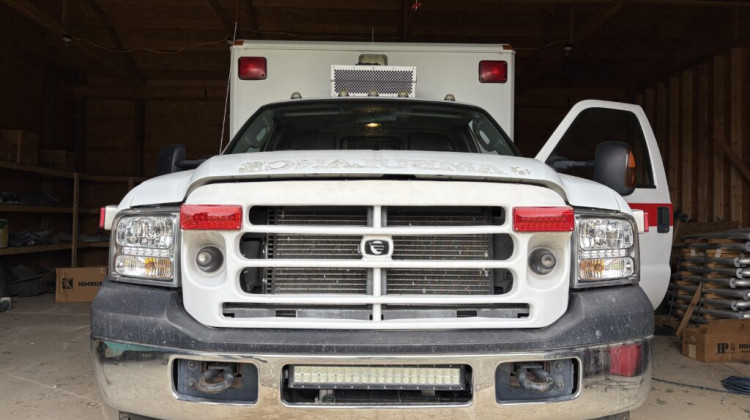
Christina Gerlach is a crisis services manager at UnityPlace, a Living Room managed by UnityPoint Health in Peoria, Illinois.
Carter Barrett / Side Effects Public MediaIf you or someone you know may be considering suicide, contact the National Suicide Prevention Lifeline at 1-800-273-8255 (En Español: 1-888-628-9454; Deaf and Hard of Hearing: 1-800-799-4889) or the Crisis Text Line by texting HOME to 741741. Beginning July 16, the Lifeline can be reached by dialing 988.
After a bad breakup, 19-year-old Benjamin Kowalczyk said everything felt like it was crumbling around him. He dropped out of college, and felt himself getting angry with his family.
“I had fallen into a bad depression state,” said Kowalczyk, who lives outside Chicago. “So, you know, at that point, I realized, like, I need to get back into therapy. And I need to do something about my mental health because it's declining very quickly.”
He worried it would take too long to see his old therapist. Kowalczyk’s mom called around, and was told about Forever Hope, a “Living Room” in Chicago operated by Thresholds, a community-based mental health provider.
Kowalczyk had never heard of a Living Room — places designed as an alternative to emergency rooms, where people having suicidal or homicidal thoughts, panic attacks, severe depression, or struggling with substance use can easily find help. There are nearly two dozen Living Rooms scattered across Illinois – and at least a dozen other states have similar models – all aiming to give people in crisis a safe, comfortable place to go.
Kowalczyk and his mother made the half-hour drive and spent about 30 minutes with one of Forever Hope’s counselors. In their follow-up meetings, the counselor helped him find a therapist and psychiatrist.
“It was just such an enlightening experience going there for the first time. It made me feel like I actually had somewhere safe to go,” said Kowalczyk, who says he’s doing a lot better today. He still goes to the Forever Hope once or twice a week, in addition to therapy.
In Illinois, providers hope the Living Room model will help fill the gap in mental health services, as the nation’s new mental health crisis number, 988, rolls out this month. The three-digit version of the National Suicide Prevention Lifeline launches July 16 and aims to make it easier for people in crisis to connect with trained counselors.
While most 988 calls are expected to be resolved over the phone, there will be people who need in-person assistance. And for those in crisis, the options for appropriate places to go remain few and far between.
Now, some states are trying to plug these gaps. A part of this solution could involve places like Living Rooms that offer an alternative to the emergency room and jails, which often become the default providers of emergency mental health care.
At UnityPlace, a Living Room managed by UnityPoint Health in Peoria, Illinois, there’s a large room with recliners, a Nintendo Wii, and a television. Tucked into a corner is a coffee machine and snacks.
A better option for mental health care
Emergency rooms are not an ideal place to receive mental health care. They’re loud, overstimulating and staff don’t always have mental health training. It’s not uncommon to wait hours for care, in rare cases, more than an entire day.
Living Rooms are designed to provide a home-like atmosphere. They are usually grant-funded, and primarily staffed with recovery support specialists who have at least a year of mental health training and personal experience with mental health struggles or addiction.
It’s important to understand that mental health crises look different for different people, said Ann Raney, CEO of The Living Room at Turning Point in Skokie, Illinois.
“We have never turned anybody away because of their definition of crisis,” Raney said. “It could be someone who saw a car accident, it could be someone who's having a … mental health issue. It could be somebody who's lost a job.”
At UnityPlace, a Living Room managed by UnityPoint Health in Peoria, Illinois, there’s a large room with recliners, a Nintendo Wii and a television. Tucked into a corner is a coffee machine and snacks.
As with all Living Rooms in the state, guests can just walk in – no doctor’s note or payment required.
“We have absolutely had clients come in here who were definitely struggling … and have said, ‘This saved my life, coming here, having this to be able to talk to somebody,’” said Christina Gerlach, the crisis services manager at UnityPlace.
Limited, but promising evidence
One downside of living rooms in Illinois is they aren’t open 24/7, due to insufficient funding. Even still, the evidence of these facilities is promising, albeit limited.
In one small study, researchers found of the more than 200 visits to a Living Room outside Chicago, 93 percent of them didn’t need further care at an ER. Lead researcher Michelle Heyland said this saves money for both health care providers and patients.
Emergency room visits can cost thousands of dollars, while the cost of a single Living Room visit is $269, according to the same study.
The research found two-thirds of participants reported that learning coping skills was the most helpful aspect of their Living Room experience, said Heyland, an associate professor at Rush University in Chicago.
“Eighty percent said the most helpful thing was the ability to talk through the situation and problem solve,” she said.
One of the goals of the Living Room approach is to connect people with outside resources and prevent future crises.
In Illinois, leaders of Living Rooms aren’t sure if the 988 rollout will mean a sudden influx of visitors, especially if it takes time to build public awareness of both 988 and Living Rooms.
"People know what an ER is, people know what therapists are … but a Living Room still doesn’t resonate with the general public,” said Patricia Johnstone, Living Room director at Trinity Services in New Lenox, Illinois.
In the meantime, Living Room leaders say they’re carefully watching for an influx of visitors.
“There's no better feeling for me to have someone come in, and they're at the worst moment in their life sometimes,” said Matthew Tassinari, who oversees the counselors at Forever Hope in Chicago. “They're in distress. They're crying. And to have them leave with a smile on their face, to know that they have a safe place to come back to ... it's truly amazing.”
This story comes from Side Effects Public Media — a public health news initiative based at WFYI. Follow Carter on Twitter: @carter_barrett.
Side Effects is part of the Mental Health Parity Collaborative, a group of newsrooms that are covering challenges and solutions to accessing mental health care in the U.S., with a focus on Arizona, California, Georgia, Illinois, Pennsylvania and Texas. Partners on this project include The Carter Center and The Center for Public Integrity.
9(MDAyMzk1MzA4MDE2MjY3OTY1MjM5ZDJjYQ000))
 DONATE
DONATE






 Support WFYI. We can't do it without you.
Support WFYI. We can't do it without you.